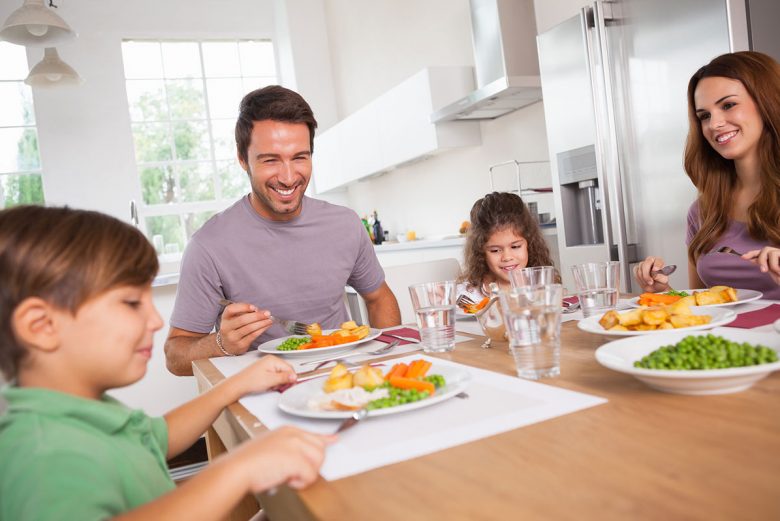
Let’s make mealtime meaningful
Family dinners bring people together and contribute to your children’s success and sense of stability. But what if getting everyone to the table feels like a feat—or a fight?
In this episode, Carol and Anne share simple ways to help you all sit down for meaningful meals together. Just a few small changes can make a world of difference, no matter which of the 4 Types of children you’re raising.
This episode’s Parenting Practice
Ask yourself if family dinners are going the way you would like them to. If not, choose one of the tips from this podcast episode to put into practice. It takes practice to find what works for your family, so be patient, find out what’s getting in the way, and create the experience you want together.
Transcript of podcast episode
Carol: Welcome to The Child Whisperer Podcast. I’m your host, Carol Tuttle, author of the best-selling parenting book, The Child Whisperer. I’m with my co-host, Anne Tuttle Brown. The grand finale of our series, “Eating Tendencies for the Four Types of Children,” we want to support you with 5 steps to create successful family dinners. And Anne is actively involved in feeding a family of five right now and has some great tips to share with us. I was very successful in meal planning and dinner prep, as well…
Anne: I remember a lot…
Carol: …so I’ll throw in any advice I have.
Anne: Yep, yes. I remember a lot of family dinners, delicious family dinners, around the dinner table, so…
Carol: Yeah. So I had a good role model, my mom was very good at it. So modeling is…I think, makes a difference. You’re influencing your children and developing those habits that goes on for generations because you’re the third generation that I’m aware of. Maybe my mother…my grandmother was very good at it. But my mom showed me how to do it in a way that was easy and pleasurable. I did it, and you’re doing it now.
Anne: Yeah, well, it wasn’t that way for a while. I actually really detested dinner time because I was cooking food that I felt like nobody wanted to eat, and by the time I finally sat down, after I was serving everybody up and getting the forgotten fork or getting some water, I finally sat down, and everybody was done eating, got up, and I was sitting there by myself and…
Carol: Really?
Anne: …really frustrated. Yeah.
Carol: Yeah, I bet, especially for a Type 2. All this planning, preparation, and I wanted to connect with all of you. You’ve all disappeared.
Anne: And then having a particular Type 2 eater, I’m just like, “Now you haven’t eaten nothing, and I don’t know what to make.” And just kind of going through this, this really…like, and I finally…
Carol: Like, “I give up.”
Anne: I confessed to myself, “I hate this. I really do not enjoy making dinner anymore.” And it hasn’t always been that way, I love to cook, you know?
Carol: Mm-hmm.
Anne: And meal planning, I think, comes more naturally to me, and so something needed to be done. And it was kind of really hit a point of frustration after the initial Covid shutdowns, back in March 2020, when we were just eating dinner at home all the time. I was like, “I’ve got to do this every day.” So I needed…I noticed I needed to fix some things, and I read a book that I’ll reference that was really helpful. It’s French Kids Eat Everything. I have a connection with French…studied French all through high school and college, and lived there for a while. And so I’m always interested…
They have such refined cuisine and way of doing things. So there were a lot of helpful tips in there. And just applying it from… I’ll share some tips from my own experience. But we’ve…I think everybody knows that family dinner, there are benefits from sitting down together as a family, and I just did kind of a quick search. And just to share some of the benefits, it helps the family handle stresses of daily life. And eating together tends to promote more sensible eating habits and helps family members manage their weight more easily. That was actually an interesting one that I thought…I hadn’t thought of before, but… And, obviously, the connection that comes. I have many memories from family dinners, and I know you do, as well, like things that your mom would always make or, you know, just stories and connection, being together.
Carol: Well, I think the focus is being together and eating versus when you’re not sitting down and having a meal together, you’re usually feeding yourself while you’re doing other things.
Anne: Mm-hmm.
Carol: And you’re not conscientious about what you’re putting in your body.
Anne: Yeah.
Carol: So that would relate to me as it does support people and better weight management…
Anne: Yeah.
Carol: …for that reason.
Anne: Well, my husband had a Type 1 mom who did not enjoy meal planning or meal preparation. They would do Sunday dinner, and they would make it a big to do. But most nights, he was preparing himself his own food, or his mom was bringing food home.
Carol: He’s just probably grabbing something to eat, too.
Anne: Yeah. And he just…he always praises me so much, like, “This is amazing, thank you,” because it’s…so it’s not what he grew up with, which is very encouraging to me. So the first step is to determine what is for dinner. So we have…you know, we shared a lot of ideas for each different…each Type of parent in the other four podcasts, about ways to make it easy for you so you can look at that. And one that I would just share is kind of plan in those breaks where you can make it easy on yourself, and so you’re not planning, you know, a big gourmet meal every night, where maybe you have breakfast for dinner one night, or you’re eating out once or twice a week. And so you can just kind of ease your…lighten your load a little bit. That has helped me, definitely.
And also to expand beyond… I shared this in the Type 2 podcast, so you have the main dish and like a couple sides, and then what extra items can you bring to the table, too, I think it makes it a little bit more fun and it also makes sure everybody has something that they can eat. So we’ll bring nuts, like pistachios, pecans, almonds, or, you know, just fruit or toast. Or I’ll make muffins, even if it doesn’t, like, jive with the whole meal, just to make sure there’s extra so everybody can put something on their plate that they will enjoy.
Carol: We’ve got more Child Whisperer coming up right after this brief message.
Announcing: Knowing your Type and your child’s Type changes everything, doesn’t it? It helps you to understand one another better. It can help your outside, too. When you wear clothes that express your type, you feel better, you look better, and people understand you more easily, including your kids. Carol Tuttle created the Dressing Your Truth program to help you dress true to your type and create a personal style that expresses who you really are. The best part? You can learn all the basics for free. Start loving how you look and feel at dressingyourtruth.com.
Anne: The second tip I share is to set a dinner start and end time. So at dinner, this is where it really made a lot of sense in my mind. I was like, “Oh, why am I doing that to myself?” I had, in my mind, said dinner should start at 5:30, but three nights a week, I would get home from work at 5:15. How am I going to get dinner ready in 15 minutes? And so I pushed dinner back to 6, and I get home from work a little earlier now, but now I give myself a full hour to just make dinner, and I take the time that I need. And as a Type 2, especially, that has made it a more enjoyable experience, where I can…I’m not feeling rushed to try and, you know, get dinner on the table.
And then I also have an end time. I expect that our family should sit together for 30 minutes, at least. And I have little ones, you know, ages three to nine, so maybe it could go a little longer if you’re having conversation with older children and enjoying that. But I would, in the beginning, set a timer and say, “Nobody can leave. You have to ask to be excused.” And that was important to me to create the time and the space for conversation to happen, and to just sit down and enjoy, that it was more than just a meal to shovel down and to move on.
This goes along with the next tip, which is to create an atmosphere, and so we started lighting candles. Around Christmas time, we had like an Advent calendar that we would do, and my kids look forward to that now. We have a candle that we use for dinner, and we all take turns lighting or blowing out. Sometimes that can take…we have to light six matches, so everybody gets a turn but… And also, even, well, if we make tacos, we’ll turn on Mexican dinner music, you know, in the background, or if we’re having Italian. And so we’re theming, and my kids really enjoy that.
And then, also, we used to have like self-serve at the counter, and I’ve switched that to making it family-style, so we bring everything to the table. And rather than serving it in the pot that I made it in or the, you know, frying pan, I put it on nice platters. And for Mother’s Day, last year, that’s what I asked for, was some nice serving platters. And so it does cause, you know, maybe a couple extra dishes, but I really look forward to creating a nice spread on the table.
So creating an atmosphere where it can just feel like this is something that’s set apart. It’s feeling different than snack time or even lunchtime. And this is an opportunity for all of us to come together, which goes to the next step, which would be engage with each other. It’s more than a meal, it’s about connecting and communication. And so we put our phones away, and we have a couple different games that we play at dinner, so we’ll ask questions, “So what did you do that was fun today? How did you help somebody? What did you learn?” And we’ll each take a turn answering those questions. Or some nights we’ll say, “Why I love you,” and we’ll go around and say, “Everybody say why you love Katie,” or, “If you could move anywhere in the world, where would you go?” Or, what did we play last night? And the kids… Oh, we were, like, quoting, like, superheroes or movies, and then we got quoting each other, like things that Roy will say a lot, like, “Who am I?”
And that was really fun, so… Or you can even, you know, review the week, or what’s coming up the next day, what do you need to prep for. And I would say it’s important to, rather than the parents having their own conversation, or the adults at the table getting into a conversation where the kids will zone out, keeping the children engaged, and on a level where they can… My kids look forward to that so much, to just be with each other and talk about how each other’s day went.
And then the last step would be get everyone helping. So with the setting the table, my three-year-old, he’ll set out the placemats, and he’ll get the table. He likes to do the forks. Like, even at that young age, they can help. And with… We have one of those choppers where you just put the vegetables on and close the lid, my kids love to help with that, or to stir the soup, or to pour ingredients in. It’s not my favorite thing to do. I’ll be honest, because it’s like, “You’re going to spill that flour,” or, “That eggshell’s going to get into the bowl.” But as I do it more, it’s something that gets a little bit easier as they’re learning, and I think that that engagement is so important.
And then, when dinner is done, ask to be excused, and then they clean up their table. And then, when they get older, we’ll have, you know, them do the dishes. And Katie, last night, was helping me wipe tables and vacuum and just making it a full experience. As a mom who, like, you know… And there are dads who make the dinner, but whoever is the primary, like, person making the meals, you know how much effort has to go into these and happens so frequently. It’s like the planning and the prep, and the grocery shopping, and then the making the meal, and then the cleanup. And I think I’m trying to build in my kids an appreciation for what is required for those meals. And getting them involved in the little bits of work along the way, I think, helps them appreciate it more.
So I would ask yourself, if you’re not having regular family dinners and, you know, whatever that looks like in your family, maybe it is, you know, just a couple times a week, what’s getting in the way? Is it your overwhelmed as a parent, not wanting to take the time to plan and prep? Are your children’s activities happening at a time in the day where you can’t get together for dinner? Or is a spouse coming late home from work and you’re not being together?
So, where can you make adjustments? And how can you make it work for your family? Maybe it’s moving it to a later time. Maybe it’s just getting everybody really involved and making it happen. I had to…I felt like it was something I was so passionate about that I really stuck to my guns in some areas, being like, “You sit down, you come back to this table. Like, we are talking. We need to keep…” Like, trying to come up with games to play or conversation starters. So your parenting practice for this week is to just assess your family dinners and what’s inspiring you now to make them even better.
Carol: Thanks for listening. For more support, go to thechildwhisperer.com, where you can purchase the book, subscribe to our weekly Parenting Practice email, and find a transcription and audio of “The Child Whisperer Podcast.”
Anne: If you’re listening on iTunes, thank you for leaving a review. If you have a parenting question, please send it to [email protected].



